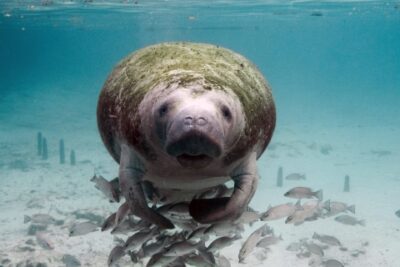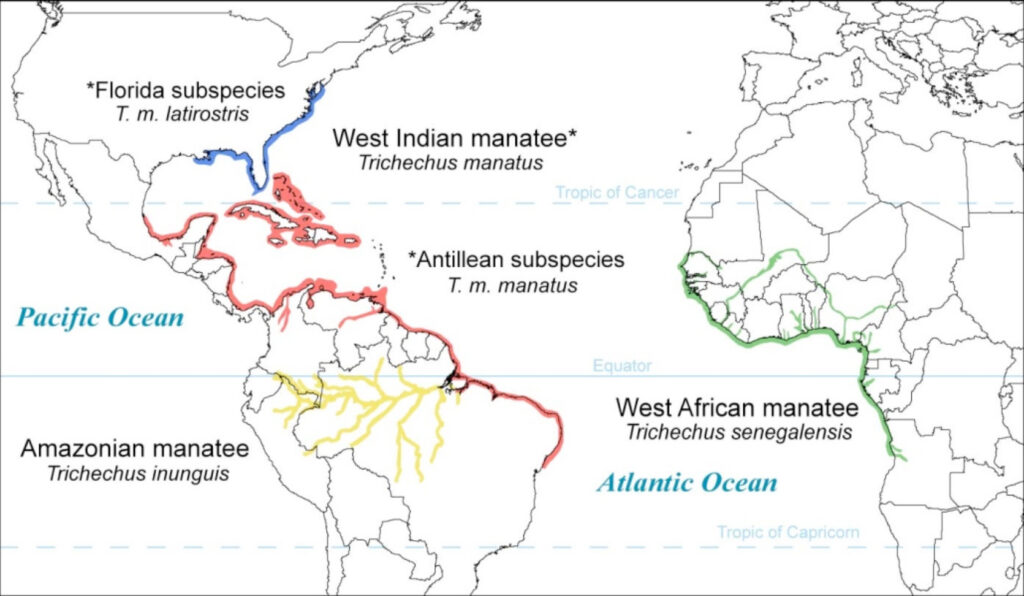West Indian Manatee
West Indian Manatee(Trichechus manatus)
Description

A Florida Manatee (Trichechus manatus latirostris) in Crystal River, FL. Algae often grows on the backs and tails of manatees, which makes their skin color appear green or brown. A manatee’s leathery-looking, thick skin continuously flakes off, however, an adaptation that helps keep the algae, as well as barnacles, from building up on their body surface. Photo credit. U.S. Fish and Wildlife Service.
Manatees are large, aquatic mammals found in marine, brackish, and freshwater systems throughout coastal and riverine areas of the southeastern U.S., eastern Mexico, Central America, northern South America, the Caribbean Islands, and West Africa. They use their paddle-like front flippers and highly maneuverable muscular lips to grasp plants and spend up to eight hours a day grazing on seagrasses and other aquatic vegetation.
There are three extant manatee species: the West Indian (Trichechus manatus spp.), African (Trichechus senegalensis), and Amazonian manatee (Trichechus inunguis). The West Indian manatee is the largest manatee species, weighing up to 1500 kg (3300 lb) and measuring 4 m (13 ft) in length. The species is divided into two subspecies: the Florida manatee (Trichechus manatus latirostris) and the Antillean manatee (Trichechus manatus manatus). The Florida manatee is found primarily in U.S. coastal waters, rivers, and springs of Florida. During the summer, Florida manatees may expand their range, and, on rare occasions, are seen as far north as Massachusetts and as far west as Texas on the Gulf coast. The Antillean manatees’ range includes Central America, northern South American, and the Caribbean.

Global distribution map for the three extant species of manatees. The range of the West Indian manatee is shown in blue/red (Florida subspecies in blue, Antillean in red); Amazonian manatee in yellow; and West African manatee in green. Image credit: Gonzalez-Socoloske, D. (2012). Gentle Giants in Dark Waters: Using Side-Scan Sonar for Manatee Research. The Open Remote Sensing Journal, 5(1), 1–14. https://doi.org/10.2174/1875413901205010001. Image CC-BY 4.0.
Manatees produce frequency modulated vocalizations that are thought to be created via vocal folds of the laryngeal (throat) region. Although West Indian manatee subspecies live in geographically different areas, they produce similar underwater sounds. Their vocalizations are complex, short duration (200-800 ms), frequency-modulated calls with multiple harmonics.
Florida manatees produce three primary call types, squeaks, high squeaks, and squeals. The fundamental frequencies range from 1.17 kHz to 2.83 kHz. Antillean manatees mainly produce squeaks, trills, and chirps, with mean fundamental frequencies ranging from 0.64 kHz to 5.90 kHz (up to 8.1 kHz for captive animals). Both subspecies have been found to produce acoustic signals in the ultrasonic range above 20 kHz. One study showed the majority (~70%) of Antillean manatee calls to include ultrasonic harmonics (maximum frequencies up to 88.3 kHz).
Many squeak vocalizations have been recorded for mothers and calves, which form the only long-term association in manatees (for up to 2 years). Calves are very vocal, producing calls 2-6 times more frequently than their mothers, especially when separated. The squeak structure and call rates differ among cow/calf pairs. These calls act as a contact call, often preceding movement until mothers and calves are reunited. “Hill-shaped” higher frequency squeaks (i.e., they look like hills on a spectrogram) are often associated with calf presence. Brady et al. (2022) found smaller manatee calves produce hill-shaped calls which have spectral characteristics that flatten out as a calf grows and body size increases. Vocalizations produced by adult females also have a flattened structure.

Diagram showing frequency contour changes in the vocalizations of the Florida manatee (T. m. latirostris) and the Antillean manatee (T. m. manatus) over time. As the manatees grow larger (from a calf to an adult), their vocalizations shift in structure from a hill-shape contour to a more linear call (as seen on a spectrogram). Figure used with permission, under a Creative Commons Attribution 4.0 International License, from Brady, B., Ramos, E.A., May-Collado, L. et al. Manatee calf call contour and acoustic structure varies by species and body size. Sci Rep 12, 19597 (2022). https://doi.org/10.1038/s41598-022-23321-7.
Additional Links on DOSITS
- Science > How does sound travel in shallow water? (advanced topic)
- Science > How does sound travel in very shallow waters? (advanced topic)
- Animals > Potential Effects > Anthropogenic Sound Sources > Recreational Boating Noise
- Animals > Sound Reception > Hearing in Cetaceans and Sirenians, the Fully Aquatic Ear
- Technology Gallery > Acoustic Tags
- Audio Gallery > Amazonian Manatee
- Audio Gallery > African Manatee
- DOSITS Webinar Archive > Passive Acoustic Monitoring Overview
Additional Resources
- U.S. Fish and Wildlife Service, Manatee
- Florida Fish and Wildlife Commission, Florida Manatee Facts and Information
References
- Bengtson, J. L., & Fitzgerald, S. M. (1985). Potential Role of Vocalizations in West Indian Manatees. Journal of Mammalogy, 66(4), 816–819. https://doi.org/10.2307/1380821
- Brady, B., Hedwig, D., Trygonis, V., & Gerstein, E. (2020). Classification of Florida manatee ( Trichechus manatus latirostris ) vocalizations. The Journal of the Acoustical Society of America, 147(3), 1597–1606. https://doi.org/10.1121/10.0000849
- Brady, B., Moore, J., & Love, K. (2022). Behavior related vocalizations of the Florida manatee ( Trichechus manatus latirostris ). Marine Mammal Science, 38(3), 975–989. https://doi.org/10.1111/mms.12904
- Brady, B., Ramos, E. A., May-Collado, L., Landrau-Giovannetti, N., Lace, N., Arreola, M. R., Santos, G. M., Da Silva, V. M. F., & Sousa-Lima, R. S. (2022). Manatee calf call contour and acoustic structure varies by species and body size. Scientific Reports, 12(1), 19597. https://doi.org/10.1038/s41598-022-23321-7
- Gaspard, J. C., Bauer, G. B., Reep, R. L., Dziuk, K., Cardwell, A., Read, L., & Mann, D. A. (2012). Audiogram and auditory critical ratios of two Florida manatees ( Trichechus manatus latirostris ). Journal of Experimental Biology, 215(9), 1442–1447. https://doi.org/10.1242/jeb.065649
-
Gerstein, E. R., Gerstein, L., Forsythe, S. E., & Blue, J. E. (1999). The underwater audiogram of the West Indian manatee ( Trichechus manatus ). The Journal of the Acoustical Society of America, 105(6), 3575–3583. https://doi.org/10.1121/1.424681
- Landrau-giovannetti, N., Mignucci-giannoni, A. A., & Reidenberg, J. S. (2014). Acoustical and Anatomical Determination of Sound Production and Transmission in West Indian ( Trichechus manatus ) and Amazonian ( T . inunguis) Manatees: Sound production and transmission in manatees. The Anatomical Record, 297(10), 1896–1907. https://doi.org/10.1002/ar.22993
- Merchan, F., Guerra, A., Poveda, H., Guzmán, H. M., & Sanchez-Galan, J. E. (2020). Bioacoustic Classification of Antillean Manatee Vocalization Spectrograms Using Deep Convolutional Neural Networks. Applied Sciences, 10(9), 3286. https://doi.org/10.3390/app10093286
- Miksis-Olds, J. L., Donaghay, P. L., Miller, J. H., Tyack, P. L., & Reynolds, J. E. (2007). Simulated vessel approaches elicit differential responses from manatees. Marine Mammal Science, 23(3), 629–649. https://doi.org/10.1111/j.1748-7692.2007.00133.x
- Miksis-Olds, J. L., & Tyack, P. L. (2009). Manatee ( Trichechus manatus ) vocalization usage in relation to environmental noise levels. The Journal of the Acoustical Society of America, 125(3), 1806–1815. https://doi.org/10.1121/1.3068455
- Nowacek, D. P., Casper, B. M., Wells, R. S., Nowacek, S. M., & Mann, D. A. (2003). Intraspecific and geographic variation of West Indian manatee ( Trichechus manatus spp. ) vocalizations (L). The Journal of the Acoustical Society of America, 114(1), 66–69. https://doi.org/10.1121/1.1582862
- O’Shea, T. J., & Poché, L. B. (2006). Aspects of Underwater Sound Communication in Florida Manatees (Trichechus Manatus Latirostris). Journal of Mammalogy, 87(6), 1061–1071. https://doi.org/10.1644/06-MAMM-A-066R1.1
- Ramos, E. A., Maust-Mohl, M., Collom, K. A., Brady, B., Gerstein, E. R., Magnasco, M. O., & Reiss, D. (2020). The Antillean manatee produces broadband vocalizations with ultrasonic frequencies. The Journal of the Acoustical Society of America, 147(2), EL80–EL86. https://doi.org/10.1121/10.0000602
- Reyes-Arias, J. D., Brady, B., Ramos, E. A., Henaut, Y., Castelblanco-Martínez, D. N., Maust-Mohl, M., Searle, L., Pérez-Lachaud, G., Guzmán, H. M., Poveda, H., Merchan, F., Contreras, K., Sanchez-Galan, J. E., Collom, K. A., & Magnasco, M. O. (2023). Vocalizations of wild West Indian manatee vary across subspecies and geographic location. Scientific Reports, 13(1), 11028. https://doi.org/10.1038/s41598-023-37882-8
- Rycyk, A. M., Bauer, G. B., Wells, R. S., Gaspard Iii, J. C., & Mann, D. A. (2022). The influence of variations in background noise on Florida manatee (Trichechus manatus latirostris) detection of boat noise and vocalizations. PLOS ONE, 17(5), e0268513. https://doi.org/10.1371/journal.pone.0268513